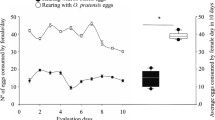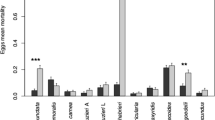Abstract
The predatory activities of commercially-purchased adult Hippodamia convergens Guérin-Méneville and two laboratory-reared strains of adult Geocoris punctipes (Say) were compared with their feral counterparts. In single prey choice feeding tests, commercially-purchased and feral H. convergens were provided copious amounts of silverleaf whitefly, Bemisia argentifolii Bellows & Perring adults or eggs of pink bollworm, Pectinophora gossypiella (Saunders). Commercially-purchased H. convergens devoured more pink bollworm eggs and at a faster rate than the feral H. convergens. In contrast, feral H. convergens consumed more adult whiteflies and at a faster rate than commercial H. convergens. In multiple feeding choice tests, two distinctly different laboratory-reared strains and feral G. punctipes were provided a cotton leaf disk containing copious amounts of silverleaf whitefly eggs, nymphs, and adults. Virtually no predation was observed on whitefly eggs, but both laboratory strains of G. punctipes fed on more whitefly nymphs and adults than the feral G. punctipes. Moreover, both of the laboratory strains had a significantly faster feeding rate on adult whiteflies and spent significantly less time feeding on plant tissue than the feral strain. These results suggest that the augmentative biological control candidates retained their ability to prey on these selected prey items, even after being displaced from their overwintering site (H. convergens) or being reared in captivity (G. punctipes) for over 40 generations.




Similar content being viewed by others
References
Bartlett AC, Lewis LJ (1978) Genetics of the pink bollworm: rust, orange, and garnet eye colors. Ann Entomol Soc Am 71:813–816
Bennett LE, Lee RE (1989) Simulated winter to summer transition in diapausing adults of the lady beetle (Hippodamia convergens): supercooling point is not indicative of cold-hardiness. Physiol Entomol 14:361–367
Cohen AC (1985) Simple method for rearing the insect predator Geocoris punctipes (Heteroptera: Lygaeidae) on a meat diet. J Econ Entomol 78:1173–1175
Cohen AC (1992) Using a systematic approach to develop artificial diets for predators. In: Anderson TE, Leppla NC (eds) Advances in insect rearing for research and pest management. Westview Press, Boulder, Colorado, pp 77–91
Cohen AC (2000) Feeding fitness and quality of domesticated and feral predators: effects of long-term rearing on artificial diet. Biol Control 17:50–54
Davis JR, Kirkland RL (1982) Physiological and environmental factors related to the dispersal flight of the convergent lady beetle, Hippodamia convergens (Guèrin-Mèneville). J Kans Entomol Soc 55:187–196
De Clercq P (2002) Dark clouds and their silver linings: exotic generalist predators in augmentative biological control. Neotrop Entomol 31:169–176
De Clercq P, Degheele D (1993) Quality assessment of the predatory bugs Podisus maculiventris (Say) and Podisus sagitta (Fab.) (Heteroptera: Pentatomidae) after prolonged rearing on a meat-based diet. Biocontrol Sci Technol 3:133–139
De Clercq P, Merlevede F, Tirry L (1998a) Unnatural prey and artificial diets for rearing Podisus maculiventris (Heteroptera: Pentatomidae). Biol Control 12:137–142
De Clercq P, Vandewalle M, Tirry L (1998b) Impact of inbreeding on performance of the predator Podisus maculiventris. BioControl 43:299–310
Driestadt SH, Flint ML (1996) Melon aphid (Homoptera: Aphididae) control by inundative convergent lady beetle (Coleoptera: Coccinellidae) release on chrysanthemum. Environ Entomol 25:259–265
Flint ML, Dreistadt SH, Rentner J, Parrella MP (1995) Lady beetle release controls aphids on potted plants. California Agricultural, March–April, pp 5–8
Grenier S, De Clercq P (2003) Comparison of artificially vs. naturally reared natural enemies and their potential for use in biological control. In: van Lenteren JC (ed) Quality control and production of biological control agents: theory and testing procedures. CAB International, Wallingford, UK, pp 115–131
Grundy P, Maelzer D, Bruce A, Hassan E (2000) A mass rearing method for the assassin bug Pristhesancus plagipennis (Hemiptera: Reduviidae). Biol Control 18:243–250
Hagen KS (1962) Biology and ecology of predaceous Coccinellidae. Annu Rev Entomol 7:289–326
Hagler JR, Cohen AC (1991) Prey selection by in vitro- and field-reared Geocoris punctipes. Entomol Exp Appl 59:201–205
Hagler JR, Jackson CG (2001) Methods for marking insects: current techniques and future prospects. Annu Rev Entomol 46:511–543
Hagler JR, Naranjo SE (1996) Using gut content immunoassays to evaluate predaceous biological control agents: a case study. In: Symondson WOC, Liddell JE (eds) The ecology of agricultural pests: biochemical approaches. Chapman & Hall, London, pp 383–399
Hagler JR, Naranjo SE (2004) A multiple ELISA system for simultaneously monitoring intercrop movement and feeding activity of mass-released predators. Int J Pest Manage 50:199–207
Hagler JR, Jackson CG, Isaacs R, Machtley SA (2004) Foraging behavior and prey interactions by a guild of predators on various lifestages of Bemisia tabaci. J Insect Sci 4:1–13
Hoy MA, Nowierski RM, Johnson MW, Flexner JL (1991) Issues and ethics in commercial releases of arthropod natural enemies. Am Entomol 37:74–75
Kieckhefer RW, Olsen GA (1974) Dispersal of marked adult coccinelids from crops in South Dakota. J Econ Entomol 67:52–54
Lehner PH (1996) Handbook of ethological methods, 2nd edn. Cambridge University Press, New York, 672 pp
Lindsley D, Grell E (1968) Genetic variations of Drosophila melanogaster. Publication 627. Carnegie Institute of Washington, Washington, DC
McCombs SD, Saul SH (1989) Genetic studies of the oriental fruit fly, Dacus dorsalis (Diptera: Tephritidae): the first eye color mutant. Ann Entomol Soc Am 82:114–115
Obrycki JJ, Kring T (1998) Predaceous Coccinellidae in biological control. Annu Rev Entomol 43:261–321
O’Neil RJ, Giles KD, Obrycki JJ, Mahr DL, Legaspi JC, Katovich K (1998) Evaluation of the quality of four commercially available natural enemies. Biol Control 11:1–8
Parrella MP, Heinz KM, Nunney L (1992) Biological control through augmentative releases of natural enemies: a strategy whose time has come. Am Entomol 38:172–179
Rankin SM, Rankin MA (1980) The hormonal control of migratory flight behavior in the convergent ladybird beetle, Hippodamia convergens. Physiol Entomol 5:175–182
Reeve JD, Guadalupe Rojas M, Morales-Ramos JA (2003) Artificial diet and rearing methods for Thanasimus dubius (Coleoptera: Cleridae), a predator of bark beetles (Coleoptera: Scolytidae). Biol Control 27:315–322
Roach SH, Thomas WM (1991) Overwintering and spring emergence of three coccinellid species in the coastal plain of South Carolina. Environ Entomol 20:540–544
Rojas GM, Morales-Ramos JA, King EG (2000) Two meridic diets for Perillus bioculatus (Heteroptera: Pentatomidae), a predator of Leptinotarsa decemlineata (Coleoptera: Chrysomelidae). Biol Control 17:92–99
Roush RT (1990) Genetic variation in natural enemies: critical issues for colonization in biological control. In: Mackauer M, Ehler LE, Roland J (eds) Critical issues in biological control. Intercept, New York, NY, pp 263–288
Saul SH (1982) Rosy-like mutant of the Mediterranean fruit fly, Ceratitis capitata (Diptera: Tephritidae), and its potential for use in a genetic sexing program. Ann Entomol Soc Am 75:480–483
Sherman F (1938) Massing of convergent ladybeetle at summits of mountains in Southeastern United States. J Econ Entomol 31:320–322
Silvers CS, Morse JG, Grafton-Cardwell EE (2002) Quality assessment of Chrysoperla rufilabris (Neuroptera: Chrysopidae) producers in California. Fla Entomol 84:594–598
Snodgrass GL (2002) Characteristics of a red-eye mutant of the tarnished plant bug (Heteroptera: Miridae). Ann Entomol Soc Am 95:366–369
Tourniaire R, Ferran A, Giuge L, Piotte C, Gambier J (2000) A natural flightless mutation in the ladybird, Harmonia axyridis. Entomol Exp Appl 96:33–38
van Lenteren JC (2003) Commercial availability of biological control agents. In: van Lenteren JC (ed) Quality control and production of biological control agents: theory and testing procedures. CAB International, Wallingford, UK, pp 167–179
van Lenteren JC, Roskam MM, Timmer R (1997) Commercial mass production and pricing of organisms for biological control of pests in Europe. Biol Control 10:143–149
van Lenteren JC, Babendreier D, Bigler F, Burgio G, Hokkanen HMT, Kuske S, Loomans AJM, Menzler-Hokkanen I, Rijn PCJV, Thomas MB, Tommasini MG, Zeng Q (2003) Environmental risk assessment of exotic natural enemies used in inundative biological control. BioControl 48:3–38
Vasquez GM, Orr DB, Baker JR (2004) Quality assessment of selected commercially available whitefly and aphid biological control agents in the United States. J Econ Entomol 97:781–788
Yamada SM, Selivon D (2001) Rose, an eye color mutation in a species of the Anastrepha fraterculus complex (Diptera: Tephritidae). Ann Entomol Soc Am 94:592–595
Acknowledgements
I thank Wendy Cummings, Christine Durand, Melissa Erickson, George Green, Scott Machtley, and Erik Stone for technical assistance. I am grateful to Mary Louis Flint, Paul Grundy, Debbie Hagler and Marshall Johnson for reviewing earlier versions of this manuscript. Special thanks go to Steve Naranjo and Becci Burke for supplying the laboratory-reared Geocoris punctipes used in this study.
Author information
Authors and Affiliations
Corresponding author
Additional information
Handling editor: Patrick De Clercq.
This article reports the results of research only. Mention of a proprietary product does not constitute an endorsement or a recommendation for its use by the USDA.
Rights and permissions
About this article
Cite this article
Hagler, J. Comparative studies of predation among feral, commercially-purchased, and laboratory-reared predators. BioControl 54, 351–361 (2009). https://doi.org/10.1007/s10526-008-9173-x
Received:
Accepted:
Published:
Issue Date:
DOI: https://doi.org/10.1007/s10526-008-9173-x




